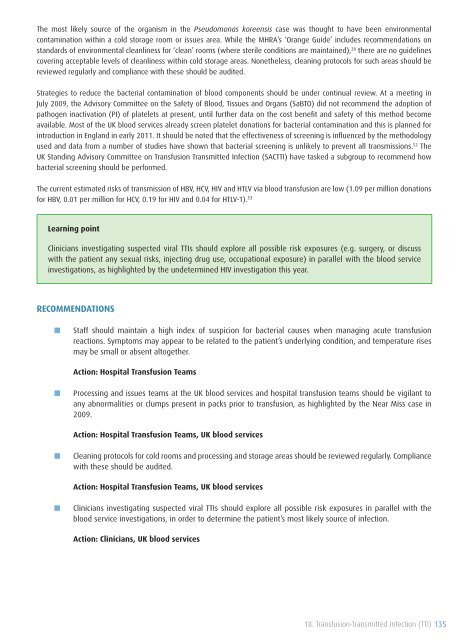SHOT Annual Report 2009 - Serious Hazards of Transfusion
SHOT Annual Report 2009 - Serious Hazards of Transfusion
SHOT Annual Report 2009 - Serious Hazards of Transfusion
You also want an ePaper? Increase the reach of your titles
YUMPU automatically turns print PDFs into web optimized ePapers that Google loves.
The most likely source <strong>of</strong> the organism in the Pseudomonas koreensis case was thought to have been environmental<br />
contamination within a cold storage room or issues area. While the MHRA’s ‘Orange Guide’ includes recommendations on<br />
standards <strong>of</strong> environmental cleanliness for ‘clean’ rooms (where sterile conditions are maintained), 28 there are no guidelines<br />
covering acceptable levels <strong>of</strong> cleanliness within cold storage areas. Nonetheless, cleaning protocols for such areas should be<br />
reviewed regularly and compliance with these should be audited.<br />
Strategies to reduce the bacterial contamination <strong>of</strong> blood components should be under continual review. At a meeting in<br />
July <strong>2009</strong>, the Advisory Committee on the Safety <strong>of</strong> Blood, Tissues and Organs (SaBTO) did not recommend the adoption <strong>of</strong><br />
pathogen inactivation (PI) <strong>of</strong> platelets at present, until further data on the cost benefit and safety <strong>of</strong> this method become<br />
available. Most <strong>of</strong> the UK blood services already screen platelet donations for bacterial contamination and this is planned for<br />
introduction in England in early 2011. It should be noted that the effectiveness <strong>of</strong> screening is influenced by the methodology<br />
used and data from a number <strong>of</strong> studies have shown that bacterial screening is unlikely to prevent all transmissions. 52 The<br />
UK Standing Advisory Committee on <strong>Transfusion</strong> Transmitted Infection (SACTTI) have tasked a subgroup to recommend how<br />
bacterial screening should be performed.<br />
The current estimated risks <strong>of</strong> transmission <strong>of</strong> HBV, HCV, HIV and HTLV via blood transfusion are low (1.09 per million donations<br />
for HBV, 0.01 per million for HCV, 0.19 for HIV and 0.04 for HTLV-1). 53<br />
Learning point<br />
Clinicians investigating suspected viral TTIs should explore all possible risk exposures (e.g. surgery, or discuss<br />
with the patient any sexual risks, injecting drug use, occupational exposure) in parallel with the blood service<br />
investigations, as highlighted by the undetermined HIV investigation this year.<br />
RECOMMENDATIONS<br />
■■<br />
Staff should maintain a high index <strong>of</strong> suspicion for bacterial causes when managing acute transfusion<br />
reactions. Symptoms may appear to be related to the patient’s underlying condition, and temperature rises<br />
may be small or absent altogether.<br />
Action: Hospital <strong>Transfusion</strong> Teams<br />
■■<br />
Processing and issues teams at the UK blood services and hospital transfusion teams should be vigilant to<br />
any abnormalities or clumps present in packs prior to transfusion, as highlighted by the Near Miss case in<br />
<strong>2009</strong>.<br />
Action: Hospital <strong>Transfusion</strong> Teams, UK blood services<br />
■■<br />
Cleaning protocols for cold rooms and processing and storage areas should be reviewed regularly. Compliance<br />
with these should be audited.<br />
Action: Hospital <strong>Transfusion</strong> Teams, UK blood services<br />
■■<br />
Clinicians investigating suspected viral TTIs should explore all possible risk exposures in parallel with the<br />
blood service investigations, in order to determine the patient’s most likely source <strong>of</strong> infection.<br />
Action: Clinicians, UK blood services<br />
18. <strong>Transfusion</strong>-Transmitted Infection (TTI) 135












